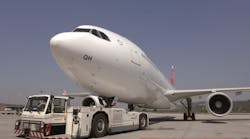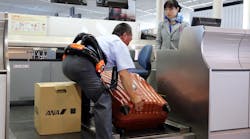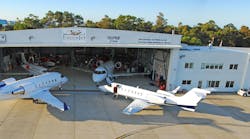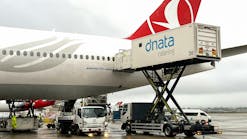Ground Handlers Are Shaping Dubai's Development
There is no doubt that Dubai is one of the world’s aviation capitals. Over the last several years Dubai has been marketing itself as the gateway to the world, and Emirates airline has witnessed sensational growth, becoming the world’s largest intercontinental airline.
The success of Dubai as an aviation hub relies also on its airport infrastructure which is witnessing major redevelopment to sustain the growth of the aviation industry in the emirate.
The Dubai airport system is composed of two main airports: Dubai International (DXB), the world’s busiest airport for international passenger traffic and the main hub for the city, and Dubai World Central (DWC).
Refurbishing works are being carried out at DXB’s Concourse C, which became part of the Terminal 3 complex used exclusively by Emirates and Qantas in 2016, while a major expansion that would more than quadruple the annual capacity of the passenger terminal at DWC to 26 million passengers is about to open.
From an aircraft ground handling point of view, the airports of Dubai are being redeveloped to prevent the constraints that exist at many older large airports, especially those that can contribute to the likelihood of ground damage.
“Optimizing infrastructure is based on our safety management principles, and the airport and its stakeholder are always looking to improve safety. An example would be how aircraft are docked at the airport. The majority of aircraft docking systems at DXB use the Safedock Advanced Visual Docking Guidance Systems (A-VDGS), which includes apron scan functionality helping to ensure that no vehicles or other objects are in the way of arriving aircraft. Objects as small as a tow bar are detected by the A-VDGS and marked on the SafeControl Apron Management display,” says Mark Rogers, Head of Stands and Capacity at Dubai Airports, the operator of both DXB and DWC.
“As an additional safety check, all stands are required to be checked manually for debris before arrival and then again before departure,” he adds. “Another way we are improving safety and efficiency is by blueprinting the head of stand area to give specific equipment designated staging areas to standardise the turn process.”
Since it opened in 1960, passenger numbers at DXB have grown on average nearly 13 percent annually. DXB now has a 90 million passenger per year capacity and it welcomed more than 88.2 million passengers in 2017.
Some of DXB’s major facilities include Concourse D, the $1.2 billion facility that represents the final element of the $7.8 billion Strategic Plan 2020, and the last major physical expansion that was possible at DXB and the home for more than 60 international airlines that operate into Terminal 1 since its opening in February 2016; Concourse A, the world’s first and largest purpose-built Airbus A380 facility, which opened in 2013, and together with Concourses B and C serve Emirates airline’s Terminal 3 complex.
DWC airport lies at the heart of an entire airport city. DWC opened in 2010 for cargo operations followed by passenger flights with the opening of a 5-7 million per annum capacity terminal in 2013. DWC is currently expanding the existing passenger terminal to accommodate 26 million passengers per annum by the end of 2018. Upon completion, the passenger terminal will provide a total of 24 boarding gates, seven baggage reclaim carousels and 104 check-in desks.
In the long term, the plan is to make DWC the world’s largest global gateway with capacity exceeding 220 million passengers and 16 million tons of cargo per year. A $32 billion (USD) expansion project is to make DWC the world’s biggest airport with a total of five 4.5km long parallel runways, each separated by a minimum of 800m in order to provide for simultaneous operation.
The central terminal area will incorporate basements, which will house a fully automated baggage handling system capable of handling around 240 million bags per annum. DWC will feature four concourses featuring an innovative 2.8 km long triple-plus layout encompassing three nodes.
The concourses, each with 100 wide body aircraft contact stands and 65 million passenger per annum capacity, will provide for more than 400 wide body contact stands. A six-track train system, connecting the airport’s two terminals with its four concourses, is designed so to allow the arriving and departing passengers to reach their destinations on a fast travel journey and will allow transferring passengers to circulate between concourses in a set minimum connect time, thus enabling them to board onward connections quickly and comfortably, according to Dubai Airports.
Aircraft ground handling companies are playing a proactive role in the development of airports in Dubai and their needs with regards to airport development are being attended.
“Ground handling companies and airports work hand in hand as both heavily rely on each other to operate at an optimal level. As safe on-time departures are essential to airlines, which are joint customers of both the airport and the ground handler, an in-sync operation is essential,” says Steve Allen, divisional senior vice president of UAE airport operations at dnata. “A ground handler manages various stakeholders along the customer journey, including the airline, the airport and ultimately the passenger. “From the on-time deployment of ground service equipment to service the aircraft when it arrives, to the welcoming of the passengers at the check-in desk, the baggage handling of those passengers, the welcoming smile in one of our airport lounges – there really is hardly any touchpoint along a passenger’s journey where the ground handler is not involved.
“During airport development, it is essential the key learnings of day to day operations are captured at an early stage,” he continues. “The joint objective should be to optimize the operation and passenger flow, and in turn minimize the additional cost of operating around a poorly designed facility.”
In the context of the developments ongoing at the airports of Dubai, efforts are being committed to avoid mixed aircraft and ground support equipment (GSE) traffic on the apron.
“Projects are underway to reduce non-turnaround critical vehicles from the GSE road network as well as taxiway crossings. Critical taxiway crossings are monitored 24/7 by a dedicated team of airside controllers. Technology is also being leveraged to automate this system based on aircraft and vehicle location tracking,” says Rogers.
Aircraft stands are also being developed with fixed ground support installations that reduce GSE movements around aircraft and thus the probability of damage.
“The majority of stands have fixed ground power and pre-conditioned air available on the stand itself to facilitate quick turnarounds and reduce the need for vehicles in proximity of the aircraft,” says Rogers. “Working collaboratively on future development areas is extremely important for both airport operators and ground handling companies. Briefing requirements that may sit outside of the aerodrome design manual well ahead of time and alerting all operators and stakeholders to new facilities coming online well in advance will allow us to be fully prepared to facilitate the needs of the handling companies.”








